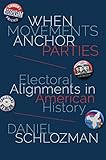When Movements Anchor Parties : Electoral Alignments in American History / Daniel Schlozman.
Material type: TextSeries: Princeton Studies in American Politics: Historical, International, and Comparative Perspectives ; 148Publisher: Princeton, NJ : Princeton University Press, [2015]Copyright date: ©2016Edition: Pilot project. eBook available to selected US libraries onlyDescription: 1 online resource (288 p.) : 5 tablesContent type:
TextSeries: Princeton Studies in American Politics: Historical, International, and Comparative Perspectives ; 148Publisher: Princeton, NJ : Princeton University Press, [2015]Copyright date: ©2016Edition: Pilot project. eBook available to selected US libraries onlyDescription: 1 online resource (288 p.) : 5 tablesContent type: - 9780691164700
- 9781400873838
- 324.209437 23
- online - DeGruyter
- Issued also in print.
| Item type | Current library | Call number | URL | Status | Notes | Barcode | |
|---|---|---|---|---|---|---|---|
 eBook
eBook
|
Biblioteca "Angelicum" Pont. Univ. S.Tommaso d'Aquino Nuvola online | online - DeGruyter (Browse shelf(Opens below)) | Online access | Not for loan (Accesso limitato) | Accesso per gli utenti autorizzati / Access for authorized users | (dgr)9781400873838 |
Browsing Biblioteca "Angelicum" Pont. Univ. S.Tommaso d'Aquino shelves, Shelving location: Nuvola online Close shelf browser (Hides shelf browser)

|

|

|

|

|

|

|
||
| online - DeGruyter Site Reading : Fiction, Art, Social Form / | online - DeGruyter Beyond Religious Freedom : The New Global Politics of Religion / | online - DeGruyter Sailing the Water's Edge : The Domestic Politics of American Foreign Policy / | online - DeGruyter When Movements Anchor Parties : Electoral Alignments in American History / | online - DeGruyter Righteous Transgressions : Women's Activism on the Israeli and Palestinian Religious Right / | online - DeGruyter Of Sand or Soil : Genealogy and Tribal Belonging in Saudi Arabia / | online - DeGruyter Sounding the Limits of Life : Essays in the Anthropology of Biology and Beyond / |
Frontmatter -- Contents -- Acknowledgments -- Abbreviations -- 1. Introduction: The Making of Anchoring Groups -- 2. Political Parties and Social Movements -- Part I. Forging Alliance -- 3. Labor and the Democrats in the New Deal -- 4. "We Are Different from Previous Generations of Conservatives" -- 5. The Limits of Influence -- Part II. Maintaining Alliance -- 6. The Price of Alliance -- 7. Alliance through Adversity -- 8. From the Moral Majority to Karl Rove -- 9. The Failure of Abolition- Republicanism -- 10. Conclusion: The Future of Alliance -- Index -- Backmatter
restricted access online access with authorization star
http://purl.org/coar/access_right/c_16ec
Throughout American history, some social movements, such as organized labor and the Christian Right, have forged influential alliances with political parties, while others, such as the antiwar movement, have not. When Movements Anchor Parties provides a bold new interpretation of American electoral history by examining five prominent movements and their relationships with political parties.Taking readers from the Civil War to today, Daniel Schlozman shows how two powerful alliances-those of organized labor and Democrats in the New Deal, and the Christian Right and Republicans since the 1970s-have defined the basic priorities of parties and shaped the available alternatives in national politics. He traces how they diverged sharply from three other major social movements that failed to establish a place inside political parties-the abolitionists following the Civil War, the Populists in the 1890s, and the antiwar movement in the 1960s and 1970s. Moving beyond a view of political parties simply as collections of groups vying for preeminence, Schlozman explores how would-be influencers gain influence-or do not. He reveals how movements join with parties only when the alliance is beneficial to parties, and how alliance exacts a high price from movements. Their sweeping visions give way to compromise and partial victories. Yet as Schlozman demonstrates, it is well worth paying the price as movements reorient parties' priorities.Timely and compelling, When Movements Anchor Parties demonstrates how alliances have transformed American political parties.
Issued also in print.
Mode of access: Internet via World Wide Web.
In English.
Description based on online resource; title from PDF title page (publisher's Web site, viewed 24. Aug 2021)


